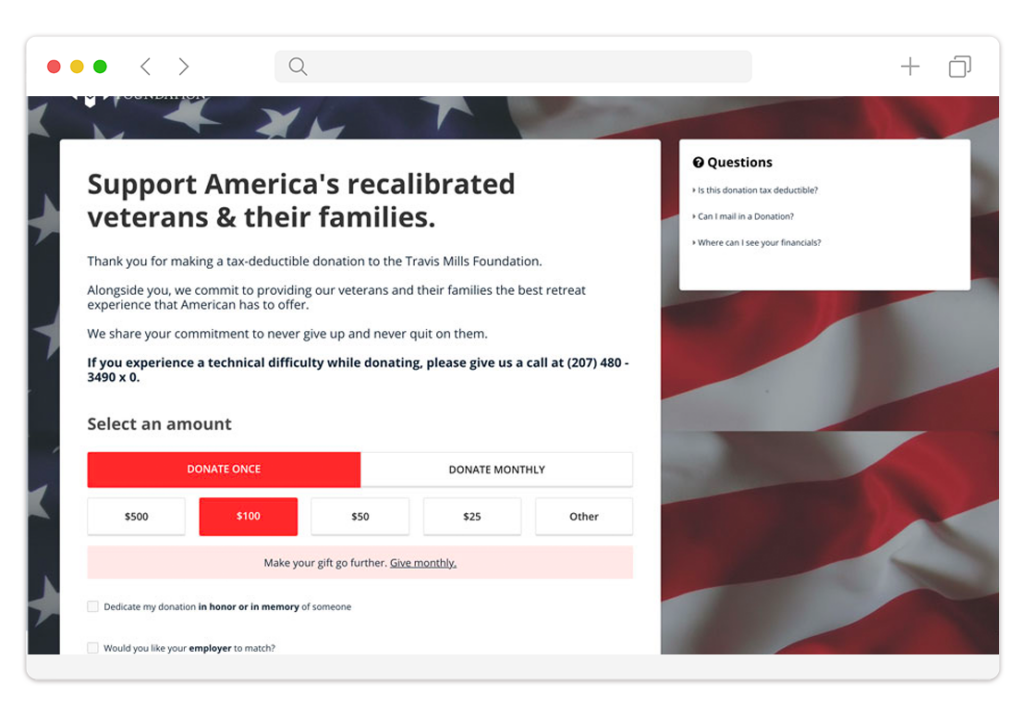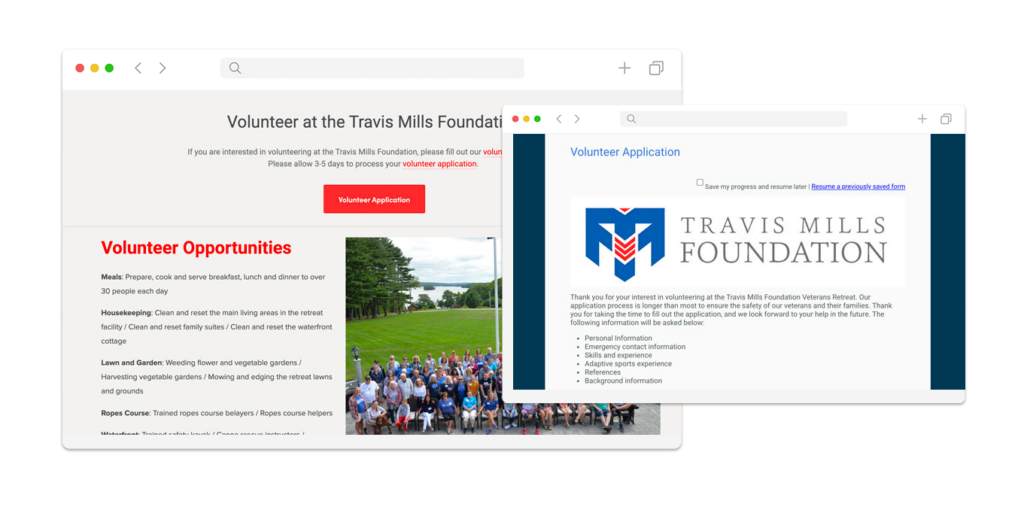Disparate donor management systems limited successful operations for services available to veterans and their families through the Travis Mills Foundation programs. Overcoming these challenges required a scalable and cost-effective solution that would increase efficiency, provide automation, and establish a central system of donation records.
The Foundation faced the challenge of utilizing multiple systems, including DonorPerfect, Classy, QuickBooks, Excel spreadsheets, Google Documents, MailChimp, Volgistics, and iWave, which were not fully integrated, resulting in inefficiencies and difficulties managing donor, veteran, and volunteer information. The siloed data management made obtaining a comprehensive view of stakeholders challenging and hindered the foundation’s ability to operate efficiently.
TMF recognized the need for a scalable and cost-effective solution to accommodate their growing capacity and ensure streamlined operations. With a relatively lean staff, they required a system that could automate processes and increase efficiency. The foundation sought an affordable solution that would allow it to expand its reach and manage donors, programs, events, and volunteers effectively while optimizing its resources.
TMF’s existing technology infrastructure lacked a central record system, causing data management and coordination challenges. With various tools and systems in place, the foundation struggled to consolidate data and maintain a clean and complete dataset for each stakeholder. This lack of a central system hindered their ability to view stakeholders comprehensively. It made tracking and analyzing vital information necessary for decision-making and effective program management challenging.
Fíonta transformed TMF’s online platform into a dynamic hub for essential information by implementing Salesforce Nonprofit Success Pack (NPSP) and Volunteers for Salesforce (V4S). The migration of donor and fundraising data from DonorPerfect to NPSP and volunteer information from Volgistics to V4S ensured that TMF could maintain comprehensive and clean datasets for all stakeholders.
Integrating third-party applications such as Classy, Conga, Quickbooks, and FormAssembly into the new Salesforce instance expanded TMF’s capabilities in donor management, program management, event management, and volunteer management, laying a solid foundation for future growth. Implementing Salesforce NPSP as the central source of truth gave Foundation staff a comprehensive 360-degree view of each stakeholder.

Fíonta utilized NPSP and V4S as the foundation for an expandable and affordable solution for TMF. This consolidation enabled TMF to manage donor and fundraising data better and volunteer information while maintaining a clean and complete data set for each stakeholder.
Fíonta integrated selected third-party apps such as Classy, Conga, Quickbooks, and FormAssembly with the new Salesforce instance. This integration extended TMF’s capacity for donor, program, event, and volunteer management while creating a solid foundation for future growth.
By implementing Salesforce NPSP as the central source of truth, TMF’s staff gained a comprehensive 360-degree view of every stakeholder. This holistic perspective allowed TMF to serve its core constituency better and make informed decisions.
The successful implementation of Salesforce NPSP and the integration of third-party apps empowered TMF to consolidate their systems, streamline operations, and enhance their support for recalibrated veterans and their families. With Fíonta’s expertise, TMF established a scalable and efficient platform that is a vital resource for their long-term programs, providing much-needed rest and relaxation to these heroic individuals.

Steering all project facets like budget, schedule, scope, and risk management while collaborating with technical leads on risk handling, our project managers serve as the primary liaison with clients, offering frequent updates on project progress.
Salesforce developers specialize in crafting and tailoring applications beyond what is available out-of-the-box using Salesforce-specific tools like Apex, Visualforce, and the Lightning Component Framework, and integrating with various systems through Salesforce APIs.
Senior strategic advisors who focus on business transformation with domain expertise in functional, platform, and integration architecture. Our technical architects articulate solutions and design trade-offs to clients, guide the delivery framework, and oversee complex solution design and development, ensuring technical integrity and soundness of the final product.
Focused on data analysis, schema design, data migration management, and complex data integration. They collaborate with clients and internal teams, handle data mappings, configure data sources, create scripts or apply tools to execute data migration and/or integrations, write test scripts, and document any deviations from original migration plans.
Specializing in Salesforce and associated systems, our experts configure client instances following technical leads’ solutions, focusing on building functionality.


